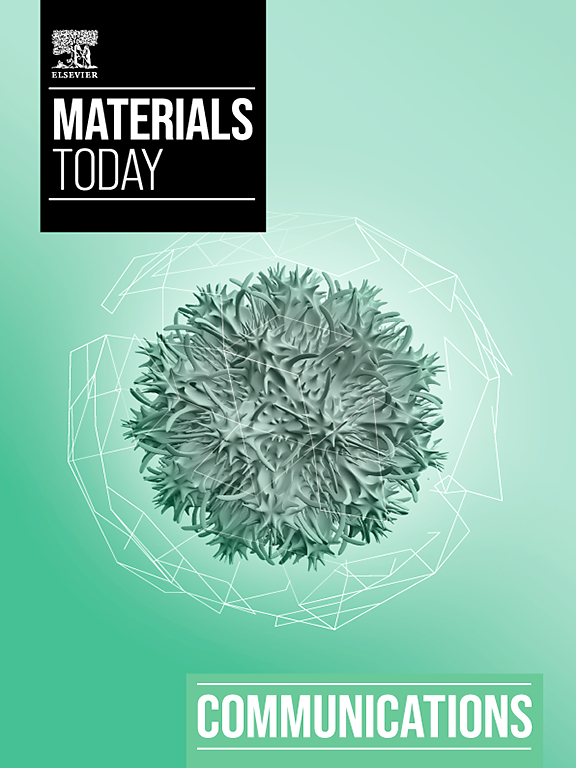Electrospun herbal extract-loaded poly (3-hydroxy butyric acid-co-3-hydroxy valeric acid) nanofiber mats as potential wound dressing materials
IF 4.5
3区 材料科学
Q2 MATERIALS SCIENCE, MULTIDISCIPLINARY
引用次数: 0
Abstract
Electrospun nanofiber mats have aroused intensive attraction for the design and development of innovative wound dressing materials, due to their high specific surface area and porosity, great air permeability, and excellent extracellular matrix (ECM) imitativeness. In this study, piezoelectric poly (3-hydroxy butyric acid-co-3-hydroxy valeric acid) (PHBV) was electrospun into nanofibers, and two different concentrations of herbal extract, Salvia miltiorrhiza Bunge-Radix Puerariae herbal compound (SRHC), were loaded into PHBV nanofibers during the electrospinning process for constructing novel wound dressings with multiple functions. All the generated PHBV mats loading with or without SRHC were observed to be constructed with randomly oriented nanofibers with the diameters ranging from 200 nm to 900 nm, and the mean fiber diameter and mean pore size presented an increased trend with the addition of SRHC. The average fiber diameter and mean pore size of PHBV nanofiber mat loading with 5 % SRHC was determined to be 649.6±242.1 nm and 2.1±0.4 μm, respectively. The addition of SRHC was found to significantly enhance the surface hydrophilicity of as-generated PHBV nanofiber mats that was changed to be hydrophilic from hydrophobic, while maintain the high mechanical properties and piezoelectric properties originated from the main polymer, i.e., PHBV. Importantly, all the nanofiber mats exhibited great biological properties, and the nanofiber mat with high SRHC content was demonstrated to significantly improve the anti-oxidant and anti-inflammatory performances, as well as promote the adhesion and proliferation of human dermal fibroblasts. The present studies demonstrated pronounced advantages of SRHC-PHBV-5 % nanofiber mats to be used as potential wound dressing materials for the wound treatment.电纺草药提取物负载聚(3-羟基丁酸-3-羟基戊酸)纳米纤维毡作为潜在的伤口敷料材料
电纺纳米纤维毡具有高比表面积和孔隙率、良好的透气性和优异的细胞外基质(ECM)仿真性,因此在创新伤口敷料材料的设计和开发中引起了广泛关注。本研究将压电聚(3-羟基丁酸-3-羟基戊酸)(PHBV)电纺成纳米纤维,并在电纺过程中将两种不同浓度的中草药提取物--丹参-葛根中草药复合物(SRHC)负载到 PHBV 纳米纤维中,以构建具有多种功能的新型伤口敷料。所有添加或未添加 SRHC 的 PHBV 纤维毡都是随机取向的纳米纤维,直径在 200 nm 至 900 nm 之间,且平均纤维直径和平均孔径随着 SRHC 的添加呈上升趋势。添加 5% SRHC 的 PHBV 纳米纤维毡的平均纤维直径和平均孔径分别为 649.6±242.1 nm 和 2.1±0.4 μm。研究发现,添加 SRHC 后,生成的 PHBV 纳米纤维毡的表面亲水性显著增强,从疏水性变为亲水性,同时保持了主要聚合物(即 PHBV)的高机械性能和压电性能。重要的是,所有纳米纤维毡都具有很好的生物特性,SRHC 含量高的纳米纤维毡能显著提高抗氧化和抗炎性能,并能促进人体真皮成纤维细胞的粘附和增殖。本研究表明,SRHC-PHBV-5% 纳米纤维毡具有明显的优势,可作为潜在的伤口敷料材料用于伤口治疗。
本文章由计算机程序翻译,如有差异,请以英文原文为准。
求助全文
约1分钟内获得全文
求助全文
来源期刊

Materials Today Communications
Materials Science-General Materials Science
CiteScore
5.20
自引率
5.30%
发文量
1783
审稿时长
51 days
期刊介绍:
Materials Today Communications is a primary research journal covering all areas of materials science. The journal offers the materials community an innovative, efficient and flexible route for the publication of original research which has not found the right home on first submission.
 求助内容:
求助内容: 应助结果提醒方式:
应助结果提醒方式:


